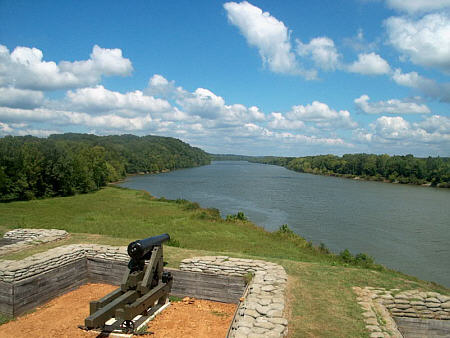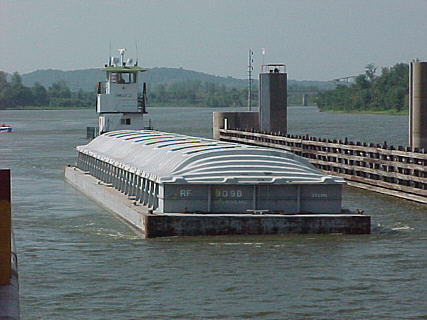|
I jerk back the throttle and Therapy casually settles into the murky water. I grab the spotlight and point it stern searching for the culprit. My heart stops when I see it - a channel marker. How could I hit a channel marker? There are only about 25 along this entire section of the Kaskaskia and I can picture every one of them in my mind. How could I hit a channel marker!
But no time to dwell on the "how" as I better think about the "what now?" I need to assess the damage and the big question - am I taking on water? Have I holed this 3/8" plywood hull? I quickly unscrew the aft 4" inspection cover on the port side of the sole. DRY! That's a relief.
The hit felt up high. Not the usual "bump in the road" that is normal with floating debris but rather a push to the side. For the moment I am now not too worried about testing Therapy's flotation characteristics but still need to look at the hull side for damage. But I don't want too! Therapy is my baby and I hate to think what I have done to her. Here on the Kaskaskia the channel markers aren't as huge as the 2' plus diameter ones on the Mississippi but still they are foam filled steel cylinders about 14" across and I was cluelessly running about 23 MPH when I clipped it. Usually when steel and wood meet head to head steel wins.
I took a deep breath and scanned up the hull side past the cabin with the light. I saw nothing. I looked more aft but still could see no evidence of a hit. I quickly glance at the inspection hatch thinking the hit must have been lower but still no water. There has to be something somewhere! I took a closer look forward and there it was. Just below the bottom of the bulwark is a green paint scrape about an inch wide and a foot long. I lean out and run my hand over it. No crack or splintered wood or fiberglass can be felt - just a good rub. I stand up but then bend over to look again just to be sure. I can't believe it - just a paint scratch.
Why was I out there in the dark? Like the sinking of the Titanic it was not just a single mistake but a series of errors and poor judgment. First - I was running behind because had stalled off some of my pre-trip prep because of items perceived to be more important (earning a living sure can get in the way of having fun!). Second - I called ahead to the Ohio River locks I would be passing through and found that unless I arrived there earlier in the day I could be delayed for several hours so I was pushing for time. And third - and most grievous, I failed to check the time of sunset and it was a half hour earlier than I expected.
The trip I was embarking on was round trip to Nashville, TN. This would entail 18 miles of the Kaskaskia River and lockage out onto the Mississippi. From there it was 117 miles to the confluence with the Ohio at Cairo, IL and then up the Ohio for 59 miles to the Cumberland River. Along the Ohio there are two locks (#53 and #52) that operate with wicket dams. If the water is high enough the moveable dam structures are lowered and traffic can pass over them avoiding the time consuming lockings. Once on the Cumberland it is 31 miles to Barkley Lock that lifts about 55 feet to Lake Barkley. Then it is 159 miles to Nashville. From there it is back the same way and the total trip would rack up about 800 miles. I planned to do it in five days.
I decided it was a good idea to drop in on the Kaskaskia the evening before my scheduled departure and run to the Lock. Once there I could get the lockage behind me and just hang on the downstream longwall of the lock for the night. (Many boats in transit use the longwall at night as a safe harbor from the high currents of the Mississippi) I figured it would save me about two hours the next morning.
Well, that was the plan. But once on the water I realized the sun was setting fast. The GPS confirmed an 8pm sunset and no moon. That meant about nine miles of the run to the lock would be in the dark but no problem. This is my home river and I know every turn. (Why does the cliché, "Ignorance is bliss" come to mind?)
Now with the adrenaline receding I very cautiously proceed the remaining 4 miles to the lock. I couldn't raise the lockmaster on the radio so I pulled the chain on the "small boat signal" and in a few minutes the miter gates opened. The drop to the Mississippi was about 8 feet and I then rounded the end of the wall and moored to the outward side. This was the first time I had spent the night here and was surprised how quiet it was. I read a while and then turned in planning an early start.
|
 Twilight
has now completely faded to black on this moonless night and I am
heading out on another trip.
Twilight
has now completely faded to black on this moonless night and I am
heading out on another trip. I sit back at the helm and
stare into the darkness. While questioning if a person can perform CPR
on himself I marvel at how solid this wooden boat has proven.
I sit back at the helm and
stare into the darkness. While questioning if a person can perform CPR
on himself I marvel at how solid this wooden boat has proven.